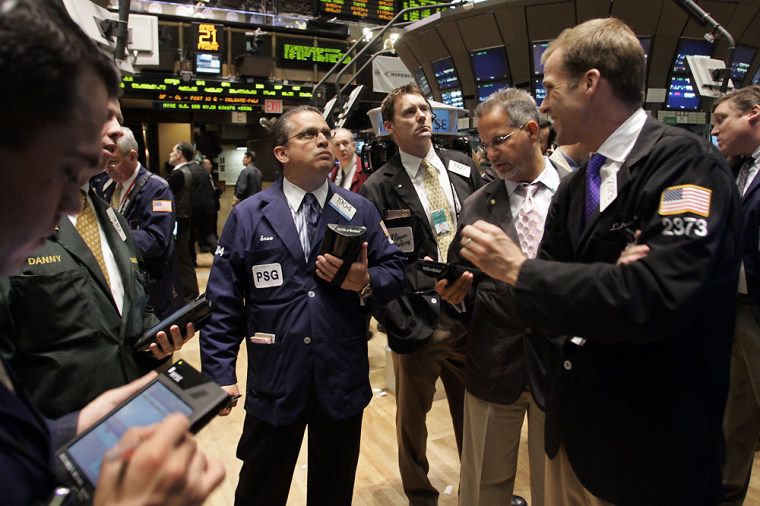China's President Hu Jintao was not amused when a Falun Gong protester managed to disrupt a formal ceremony on the White House lawn this week, but he should be pleased with the coincidental timing of the latest stock market rally.
After a long, sometimes frustrating climb from bear market lows more than three years ago, broad market indicators have pushed through to their highest levels since the heady days of early 2000, and China's rapid growth is at least part of the reason.
Strong demand from China has helped boost other Asian economies, most notably providing a baseline of support for the long-stagnant Japanese economy, which at last is showing evidence of a sustainable expansion. China's well-known role as a global factory is helping to keep a lid on U.S. labor prices and contributing to strong corporate profits.
And a series of Chinese decisions easing financial market regulations — announced just ahead of Hu's visit to the United States – might have been a factor behind the stock market's big move this week, including a nearly 200-point spike in the Dow Jones industrial average Tuesday. The benchmark indicator edged higher again Friday to close at its highest level in six years with a gain for the week of 1.9 percent.
The Chinese moves, including a change allowing individuals to buy up to $20,000 in foreign currency, up from $8,000, are expected to generate more demand for foreign securities from China's growing middle class.
But after three years of steadily rising stock values, some analysts are wondering how much longer the rally can persist, especially with U.S. growth expected to slow in the second half of the year.
And then there is the flip side of all that Chinese growth — sharply higher prices for commodities including crude oil, which rose to a record $75 a barrel Friday.
"China is emerging as a key growth engine for the world economy, contributing over a quarter of total global growth in recent years, more than any other country," Wells Fargo senior economist Scott Anderson said in a note published Friday. "The downside for U.S. consumers and businesses is that this is forcing global commodity prices higher."
Higher prices for metals and other natural resources don't always lead to consumer inflation because raw materials are such a small part of the cost for most finished products. But oil is a different story, with the ability to both fuel consumer inflation and dampen growth.
So far, consumers and businesses seem to be tolerating rising energy prices, said Jeff Kleintop, chief investment strategist for PNC Advisors.
"Oil and stocks have been moving higher together for three years," he noted. "You have got to think there would be a point where (oil) tends to stoke inflation and cut economic growth, but we just haven't gotten there yet."
In part, investors seem to be expressing confidence that the Federal Reserve is staying ahead of the inflation curve, having raised short-term interest rates 15 times in less than two years. But that streak could be coming to an end.
In minutes of last month's meeting of policy-makers released this week, central bankers indicated they were ready to move to the sidelines, suggesting to many observers that the Fed will at least pause after raising rates one final time May 10.
In the past, the end of a Fed rate-hike campaign has sometimes led to a stock market downturn, possibly because the Fed tends to overshoot and applies the brakes too hard, stunting growth. In the months after the Fed stopped raising rates in May 2000, for example, the Standard & Poor's 500 fell about 4 percent. It was just eight months later that the Fed began aggressively cutting rates in an effort to boost the flagging economy.
Similarly in 1981 the stock market fell 8 percent after the Fed stopped raising rates. But in the mid-1990s, the roaring bull market ignored those signposts, racing on during the plateau periods between Fed rate campaigns, said Sam Stovall, chief investment strategist at S&P.
Still, Stovall said, over the past 30 years the stock market generally has performed most strongly in the period leading up to the Fed's final rate move of a series. "Really most of the euphoria has already taken place," he said.
And Kleintop said the uncertainty associated with midterm elections is generally not a positive factor for the stock market.
Pat Dorsey, senior stock analyst at Morningstar.com, warns against investor complacency as the bull market settles into its run.
He sees a warning sign in narrow emerging market "spreads," pointing out that returns on many emerging market bonds currently are not much above the returns on securities issued by mortgage giants like Fannie Mae, which are considered virtually as safe as U.S. Treasuries.
"People are taking risks and not getting paid for it," he said.
He recommends to look for high quality big cap stocks that have been out of favor for years and may be available now for attractive valuations, mentioning companies like Wrigley, Dell, Wal-Mart and Amgen.
"We haven’t had a major pullback in three years," he said, and issued a caution. "One of the most powerful and dangerous biases people have is recency — the tendency to take the most recent trend and extrapolate it into the future."
